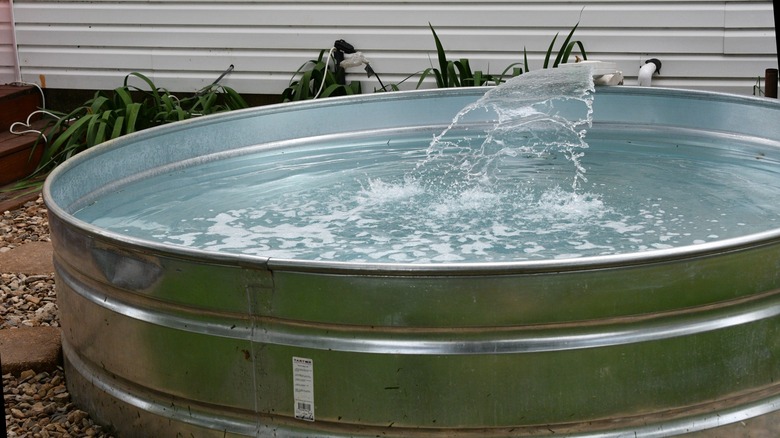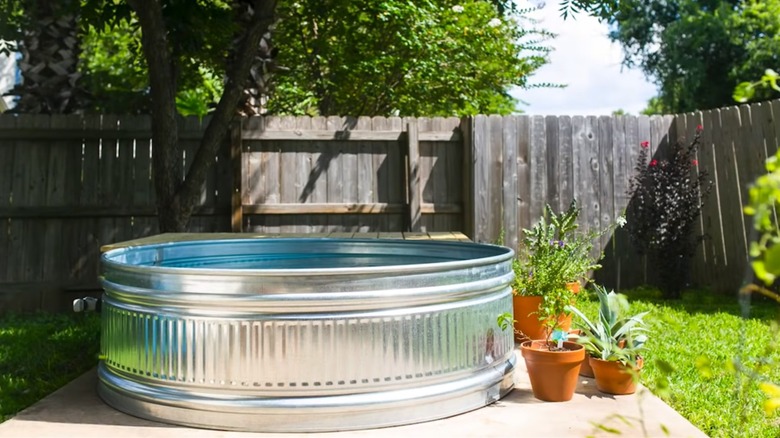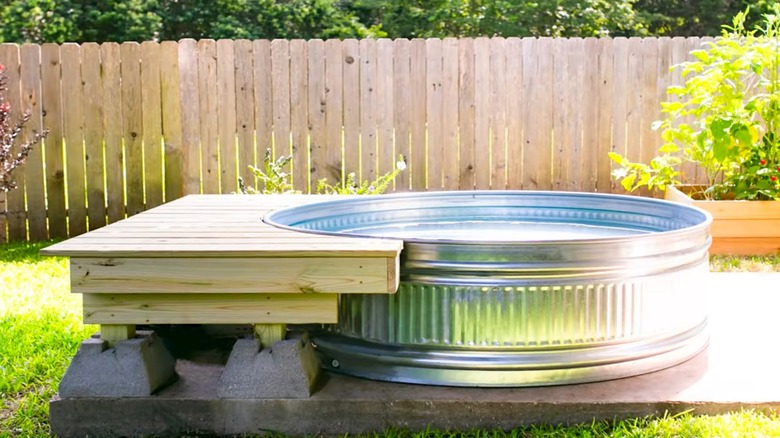Top Reasons You Should Consider Adding A Stock Tank Pool To Your Backyard
Wishing for a place to cool off from the summertime sun and heat, many of us dream of adding a pool to our backyard. There's a reason that stock tank pools have gone viral on places like TikTok and are continuing to grow in popularity: They're the perfect size for a refreshing soak, but don't take up all your backyard or break the budget. Unlike an inground pool, which can be expensive to install and maintain — not to mention, they eat up a lot of space — stock tank pools are budget-friendly and relatively simple to set up. Compared to a lot of above-ground pools (which can be really flimsy), galvanized steel stock tanks are sturdy and durable.
One of the things to know before you buy a stock tank pool is that they come in a lot of different shapes and sizes, from large round tanks to smaller oval ones, so you should be able to find an option that suits the size of your yard. Depending on the dimensions, stock tanks can cost anywhere from $160 to $600, and the other supplies are generally in the affordable range as well. You do need to purchase intake/outlet valves and drill holes in the tank for them, using marine-grade adhesive sealant to seal the edges. While an extra expense, it's worth paying a handyman to cut the holes if you're not comfortable doing this yourself. You also want to be sure to install the pool on level ground. A concrete pad is preferable, but if you can't do that you can buy and level out building sand for the base.
Maintenance is relatively simple
While a stock tank pool does require some maintenance so it doesn't get icky (here's exactly what happens when you don't clean a pool), they're still a bit less work than many other options. To keep your chores to a minimum we'd advise getting a cover and keeping it on when the pool is not in use. This will prevent any leaves, bugs, or general debris from getting in the water. There are mesh net options or solid covers — either should do the trick.
You'll also need to maintain the pump filter. Many people with stock tank pools use regular sand-based filters because they are affordable, effective, and relatively easy to maintain. The sand only needs to be replaced every few years. Some people opt for a filter glass product instead of sand as it can last for over 10 years. To keep the water clean, you'll also need to treat it with chlorine, bromine, or something similar on a weekly basis. You might want to pick up some pool test strips, like the Clorox strips ($13.98 from Lowe's). This will allow you to check the chlorine content, stabilizer, and pH of your water. And then annually (or more, depending on how often the pool is used) you'll want to drain the water, spray down the pool, and then refill it. Because the tanks are intended to hold water there shouldn't be any issues with leakage, but if you do find over time that the seals aren't holding you can use the same marine-grade sealant to close up any cracks.
There are endless customization options
If you think a stock tank pool would look like a big metal tin can in your backyard, there are plenty of ways to transform the look of your DIY cowboy pool. You can change the outside color with paint, just be sure to apply primer that's suitable for galvanized steel and use a paint that's designed for metal surfaces. If you're not shy of a little extra DIY, you can also build a small deck around the perimeter of the tank. This will make it easier to get in and out, especially for wet kiddos, though regular small pool ladders that go over the side of the stock tank can work just as well for entry and exit. Some people also dig into the ground and insert the stock tank to create a below-ground pool.
Another option is to add a collapsible overhead patio umbrella so that you can enjoy some shade while taking a dip. Umbrellas can also help keep out debris, creating less work for your filter pump. You can add a heater to make your stock tank comfortable in all weather, though, as they don't have much insulation, in colder climates you might want to only turn on the pool heater for special occasions. If you don't think you're going to be taking a warm water dip in winter, you might want to drain the stock tank pool and keep it empty — though covered — until summer rolls around again.


